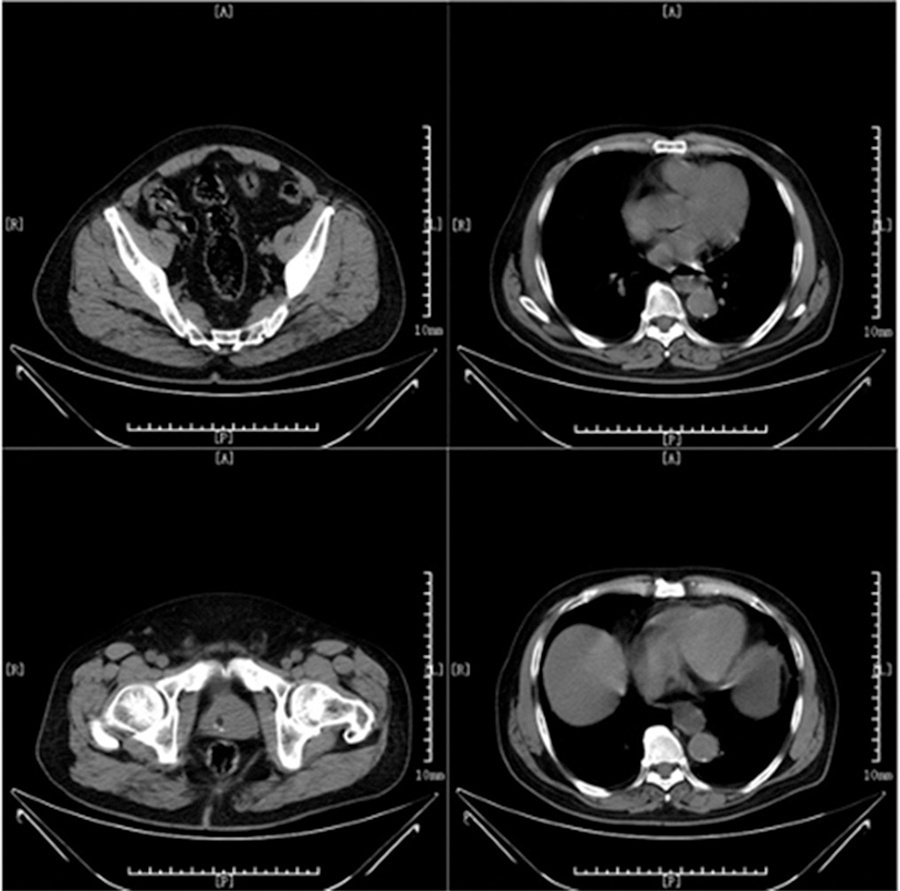Abstract
Rev Bras Ter Intensiva. 2015;27(1):77-81
DOI 10.5935/0103-507X.20150013
Rhabdomyolysis is characterized by the destruction of skeletal muscle tissue, and its main causes are trauma, toxic substances and electrolyte disturbances. Among the latter is hyponatremia-induced rhabdomyolysis, a rare condition that occurs mainly in patients with psychogenic polydipsia. Psycogenic polydipsia mostly affects patients with schizophrenia, coursing with hyponatremia in almost 25% of the cases. It is also in this context that rhabdomyolysis secondary to hyponatremia occurs most often. In this article, the case of a 49-year-old male with a history of schizophrenia, medicated with clozapine, and brought to the emergency room in a state of coma and seizures is described. Severe hypoosmolar hyponatremia with cerebral edema was found on a computed tomography examination, and a subsequent diagnosis of hyponatremia secondary to psychogenic polydipsia was made. Hyponatremia correction therapy was started, and the patient was admitted to the intensive care unit. After the hyponatremia correction, the patient presented with analytical worsening, showing marked rhabdomyolysis with a creatine phosphokinase level of 44.058UI/L on day 3 of hospitalization. The condition showed a subsequent progressive improvement with therapy, with no occurrence of kidney damage. This case stresses the need for monitoring rhabdomyolysis markers in severe hyponatremia, illustrating the condition of rhabdomyolysis secondary to hyponatremia induced by psychogenic polydipsia, which should be considered in patients undergoing treatment with neuroleptics.
Abstract
Rev Bras Ter Intensiva. 2014;26(4):407-409
DOI 10.5935/0103-507X.20140062
Haff disease is a syndrome consisting of unexplained rhabdomyolysis. Patients suffering from Haff disease report having eaten fish within 24 hours before the onset of illness. Most patients survive and recover quickly. The present study is the first report of Haff disease complicated by multiple organ failure after crayfish consumption. A 66-year-old Chinese man ate cooked crayfish on the night of June 23, 2013. He arrived at our hospital 2 days later and was admitted to the intensive care unit. After admission, the patient was diagnosed with Haff disease complicated by multiple organ failure. Despite supportive and symptomatic treatments, the condition of the patient deteriorated, and he died due to his illness.
Haff disease is a rare clinical syndrome that is sometimes misdiagnosed. Early diagnosis and proper treatment are essential to prevent progression to multiple organ failure.

Abstract
Rev Bras Ter Intensiva. 2007;19(3):292-296
DOI 10.1590/S0103-507X2007000300004
BACKGROUND AND OBJECTIVES: The Acute Kidney Injury (AKI) is the most serious complication of rhabdomyolysis. In this syndrome, the delivery of heme pigment induces an injury that distinguishes itself by glomerular vasoconstriction and direct cellular toxicity with oxidative component. The renoprotection with antioxidants has demonstrated satisfactory effect. The proanthocyanidins are natural antioxidants found in the grape seed extract. The aim of this study was to evaluate the antioxidant effect of Vitis vinifera (grape seed extract) on the renal function of rats submitted to the injury by rhabdomyolysis. METHODS: Wistar rats, male, adults, weight ranging from 250-300g were used. The AKI was induced by intramuscular administration of glycerol 50%. The animals were distributed in 4 groups: Saline group (6 mL/kg of NaCl 0.9% intraperitoneal once a day), Glycerol group (6 mL/kg) of intramuscular glycerol each femoral region received 3 mL/kg of glycerol, once a day), Vitis vinifera group (3 mg/kg/day v.o by 5 days) and Glycerol + Vitis vinifera by 5 days before glycerol). RESULTS: Renal function (RF-creatinine clearance) and oxidative profile (urinary peroxides-FOX-2 and MDA-TBARS) were evaluted. The Glycerol group treated with Vitis vinifera has shown improvements in RF and reduction levels of lipid peroxidation. CONCLUSION: The results of this study have confirmed the antioxidant protection of Vitis vinifera in AKI induced by glycerol.